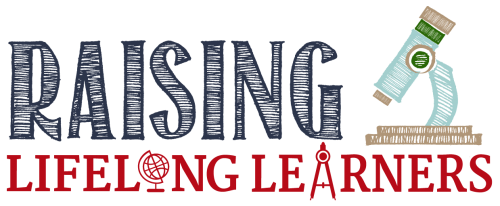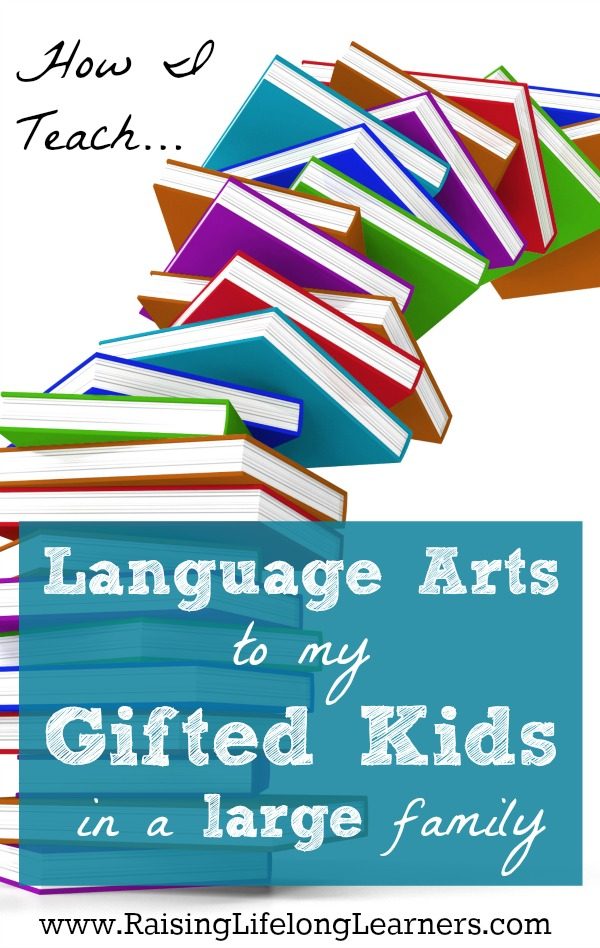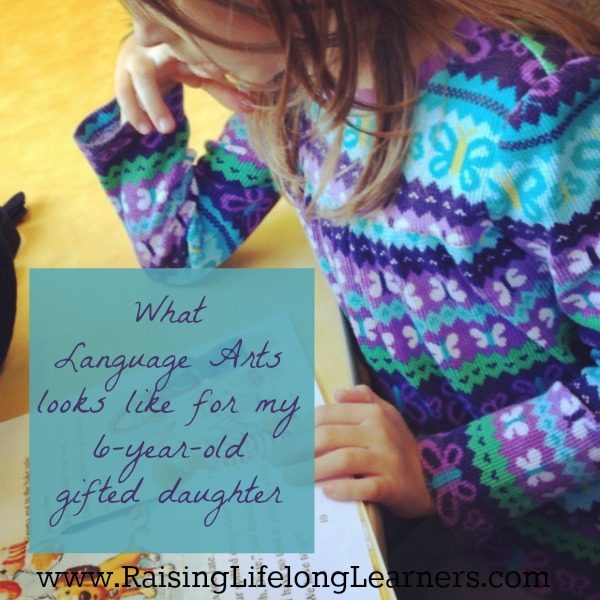How I Teach Language Arts to My Gifted Kids
Welcome to day one of a five day series — How I Teach Gifted Kids in a Large Family — a look into our day to day homeschool, broken down a subject at a time. You may want to take a moment to subscribe by email so you don’t miss a post. To easily find all the topics later, consider pinning yesterday’s post where I’ll link each article as it’s posted.
Today’s topic is a biggie. Language Arts is a huge subject that covers reading, spelling, grammar, vocabulary, handwriting, writing, and speaking. And my age-ranges run the gamut from a toddler learning not to put books into his mouth, to a preschooler discovering the sounds letters make, to a first grader chomping at the bit to be able to readers harder and harder material, all the way to an independent 11-year-old with definite ideas about what he likes and doesn’t like. Throw in their asynchronous learning abilities, giftedness, and a few sensory issues, and it can be quite a challenge to make sure everyone is learning.
So how do we do it around here?
This post contains affiliate links. Thank you for your support.
The short answer is… I don’t.
Coming from a public school teaching background, it was really hard to keep myself from getting Trevor {the only one homeschooling in the beginning} a separate curriculum and program for everything. After all, I’d always taught subjects in isolation in my classroom. Sure, we did thematic units and author studies and other creative things, but I still had to use the district’s spelling, grammar, reading, and writing programs. There was a block of time each day devoted to each of these subjects.
And in the beginning, Trevor had a spelling,, grammar, writing, and reading all laid out for him.
We’re a little more relaxed now.
I try to integrate as much of our learning as I can into interest-based topics that include all subjects. When I find points of weakness, I pull materials to address those. Let me break it down by kiddo…
What Language Arts Looks Like for My Eleven Year Old Son
Often, Trevor is working on a lapbook that has been purchased from Currclick or downloaded from Homeschool Share because he has shown an interest in learning about a specific topic. He’ll work on that during independent time — any time I’m with one of the little ones or doing something else. What I love about these is that he is busy researching {using library books we’ve checked out and the Internet}, synthesizing information into manageable chunks, writing, reporting, and then sharing his work when he reports to me or shows his finished products to friends and family.
I read aloud often to expose all of the kids to classic literature as well as great contemporary books, and Trevor reads books and magazines of his choice throughout the day.
Because he thrives on challenges, and always wants to seem {and become} smarter, I post vocabulary challenges, word puzzles, and play word games often with him.A simple thing we’ve implemented this year, that has really taken off, has been to assign him a “word of the day” using a printable from Mama’s Learning Corner. Sometime before lunch, Trevor must define the word using the printable and be ready to share the definition with the family at the table. For the rest of the day, anyone who uses the word correctly in conversation can earn a sticker for their sticker charts.
Trevor has taken this challenge further by using the Lego Movie Maker app to create stop motion animations that define the words, then showing us the video after sharing the worksheet with us at lunch.
We talk about grammar, spelling, and word usage in the context of his writing and I correct it then and there. Trevor, like most gifted kids, doesn’t need {or want} a lot of repetition to completely understand a new concept. So, once I’ve explained it, and he’s demonstrated an understanding, I move on. Though he knows that if he makes the same mistake, we may pull some worksheets at that point for remediation.
I love using puzzles and word play, and often draw word images on the whiteboard to greet him in the morning. We also play lots of fun games!
What Language Arts Looks Like for My Six Year Old Daughter
When we took Molly in for a well-visit at the pediatrician when she was sixteen months old, the doctor asked us how many words she could say. Brian and I looked at each other, and I told him that she could say anything you asked her to, and could carry on a sophisticated conversation if she was comfortable. Our doctor looked at us, smirked a bit, and jotted something down.
Then Molly pointed to the doctor’s desk and said, “Doctor C——–, why do you have a blue square on your desk?” The doctor’s jaw dropped. “I have colleagues with whom I’ve worked for over a decade who cannot pronounce my name that well. I can see what you mean now,” he said.
And Molly has continued amazing people with her precocious and highly developed vocabulary, maturity, sensitivity, and kind heart ever since.
Language Arts for my extremely bright six-year-old includes daily reading — her to me, me to her, and her to either the baby or four-year-old Logan. We have sight words encircling the ceiling in our kitchen, I write messages to her on the white board and in a special journal where we have an ongoing conversation. She received a diary for Christmas in which she writes and draws stories and notes to herself. She sends notes to friends and is already drawing and writing out Valentines to everyone she’s ever met.
I haven’t started any spelling programs with her because she’s been trying to figure things out on her own, and is doing a fabulous job. Like Trevor, she works on lapbooks based on her interests, and shares those with family and friends alike.
In some ways, teaching a gifted kid like Molly — one whose strengths and passions lie in the Language Arts — is easy. She’s motivated and driven to learn, and loves words. All I need to do for her is to have things — books, papers, pens, workbooks, activity books, and games — strewn about and she’ll make them her play.
What Language Arts Looks Like for My Little Ones
Having and teaching gifted kids at home, while little ones run around, can be extremely challenging. Some gifted kids, like Molly, are highly motivated and intrinsically driven. No matter how many interruptions happen, she’ll just keep on moving forward. Some kids, like Trevor, are easily derailed. A diaper needs changed? He’s off building a Lego ship while you’re distracted.
It can make for some long days…
And make it tough to give the little ones the attention they need.
I try really hard to give Logan and Isaac attention in the morning first thing before I do anything with the older kids. I also try to include them as much as possible with anything we do at the kitchen table. If Molly is working on a printable or worksheet, Logan will often get out one of her activity books too.
But, honestly, the most important thing at this age {4 and 1} for Logan and Isaac is to view learning and reading as fun and exciting. I put out baskets of board books, have the LeapReader and books accessible, and have lots of letter activities and games around at all times. And we read. A lot.
There are so many fabulous and fun resources available to have on hand for little ones that it’s hard to pick our favorites. But, I’ve included some in the carousel below. Check them out and put them on your wishlist. Your little ones will love them, learn from them, and free you up to work with those older ones who are asking tough questions and chomping at the bit to learn more and more.
There are so many different strategies for teaching gifted kids at home — probably as many strategies as there are gifted kids. What are some of the things that work for you?





